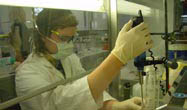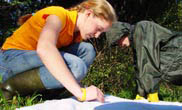| Tick Patrol HLFS Ursprung 2006 |
|
| Home | |
| Abstract | |
| Motivation | |
| Ticks | |
| The Hunt | |
| Laboratory Analysis | |
| Assignment | |
| Video | |
| Bibliography | |
| Team | |
| Imprint | |

![]()
 |
|
| We place much value on precision. Every catch is carefully charted on a map, so that each sample can later be associated with a location. |
 |
|
| The sheet must first be slept on or used to rub down a dog in order to attract the ticks. |
Motivation
Since last year the woods surrounding our school lies within the risk-zone for the contraction of tick-borne encephalitis (TBE) or Lyme disease. Considering the fact that we are an agricultural school, where much practical training is done in these woods, and that one student already contracted Lyme disease, we decided to further inform ourselves about the dangers surrounding tick bites. According to our research, there were 20 cases of Lyme disease and 3 cases of tick-borne encephalitis in the surrounding area in the summer of 2005.
As a result of these facts we came up with the idea of spending time in the elective courses genetic- and biotechnology to further inform ourselves about contagiousness, possible treatments and diagnosis of Lyme disease and tick-borne encephalitis. Experts in different subject areas came to our school to give presentations and answer questions in order to provide us with information necessary for our research.
Thanks to the zoologist Dr. Helene Polin, an expert in dealing with ticks, we were able to improve our general knowledge of this subject. The actual catching of the ticks followed theoretical lessons in the classroom, where Dr. Polin was able to give us an idea of the most important theoretical aspects.
With the general practitioner Dr. med. Christoph Dachs we discussed the diseases carried by ticks and their possible affects on the human body.
With Dr. Ilse Jekel we talked about the living-patterns and dangers of parasites in general.
Univ.- Prof. Dr. Stefan Aberle, a tick-born encephalitis expert, who works for the Institute for virology at the Medical University of Vienna, presented us with research about new innovative forms of RNA vaccinations.
We set the goal of finding out if ticks carrying bacterial Lyme disease or viral tick-borne encephalitis could be found in the woods surrounding our school. We felt that inhabitants of the surrounding areas should be informed in the case of positive findings; This could lead to more effective detection, diagnosis and treatment of infections that might occur. It is especially important that Lyme disease be detected early since this disease, when detected at an early stage, can be cured with antibiotics without having any negative long-term effects.